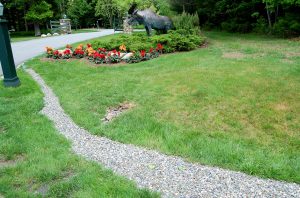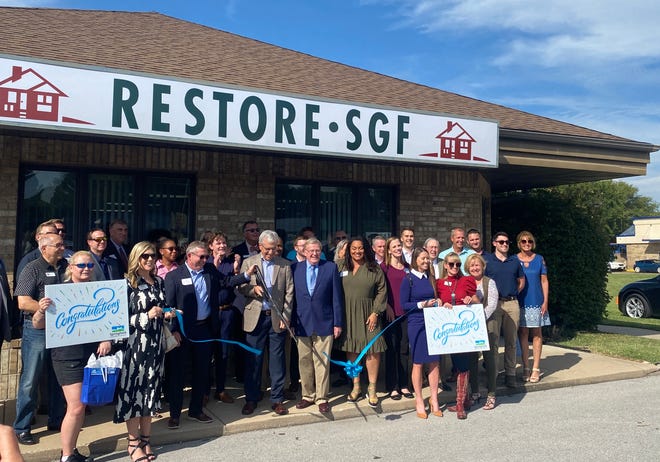Exterior improvements to homes across five Springfield neighborhoods could become easier to afford for neighbors willing to work together. Restore SGF, a local nonprofit organization dedicated to encouraging home ownership and restoring historic neighborhoods, announced the rollout of their first program as they opened the doors of their new office space.
The Block Challenge Grant Program was announced as the organization’s first installment in a series of improvement and restoration programs on Wednesday at Restore SGF’s ribbon cutting at their new offices at 1409 W. Sunshine St.
The program offers up to $2,500 reimbursement for external home improvement projects for teams of neighbors in five Springfield neighborhoods. In order to apply for this funding, neighbors have to work in teams from five to 19. Teams of five to nine people are eligible for $1,000, while larger teams can receive up to $2,500. Each team member has to be a homeowner and must be able to see their next team member’s home from their front porch.
The five neighborhoods eligible for this program are Woodland Heights, Fassnight, Grant Beach, Doling Park east of Robberson Avenue and Meador Park east of National Avenue. These were selected by a Neighborhood Selection Committee which conducted driving tours and evaluated every neighborhood based on historic features, median income, housing market activity, crime rate, nuisance property score, Community Reinvestment Act (CRA) credit eligibility, proximity to large public or private investments and other factors.
Interim Director Dana Elwell said Doling Park was split up because of the size of the entire neighborhood, while the west half of Meador Park did not qualify for CRA credits. The hope is to see success of the program and then continue to expand the program to include four more neighborhoods and then four more, he said.
The goal of this program is to create momentum of improvements across the neighborhoods and foster collaboration.
Model and other programs
This program was modeled after the ‘Invest DSM’ program in Des Moines, Iowa, and it has been in the making for three years. Richard Ollis, president of the Restore SGF Board of Directors and former councilman, said the model in Iowa showed the importance of focusing on neighborhoods and homes whose conditions are middle of the road.
“These are the neighborhoods that are at risk of swinging the other way,” he said. “It’s where we can have the most impact, at least with our initial effort.”
He said the Des Moines program also showed that people tend to invest more than the match, creating impacts larger than the program itself. The applications will be accepted on a rolling basis starting Friday, Sept. 15 until Dec. 1. Ollis said their goal is to receive at least 100 applications.
The application and more information are available online on the Restore SGF website. The application requires every individual team member’s scope of work form, ‘before’ photos and contractor bids, if applicable. Staff will render a decision usually within two weeks of submission. Following completion, team members can file their reimbursement form, receipts and ‘after’ photos.
But this program is only the beginning of Restore SGF’s efforts to assist current and future homeowners. The organization is currently working on a down payment assistance program and a revolving loan fund which are also based on the Iowa model.
The down payment assistance program plans to match money to help new homeowners make down payments on properties in the selected neighborhoods.
The revolving loan fund, which Ollis said has already collected some money, will involve Restore SGF buying properties and enlisting developers and contractors to refurbish the homes before selling them to prospective homeowners. This is a way to problem-solve the issue of what Ollis calls “missing middle housing.”
“It’s become almost unaffordable for middle-income Americans to buy a single-family home on a third of an acre lot,” he told the News-Leader.
The goal of this program would be to move away from the current model of townhomes or row homes, while still applying the principle of using land more effectively. Ollis said this would still keep the neighborhood intact and match other organization goals, but instead would aim to maximize land usage through perhaps a pocket neighborhood where 1,500 square-foot homes share common space.
“We hope to be kind of a pioneer in that area,” he said.
Eventually, once more permanent funding is secured, Ollis said they would want to launch another program focused on interior improvements that modernize older homes to fit current homeowner needs.
Who is paying for this?
The City of Springfield invested $1.3 million, while the Community Foundation of the Ozarks and 10 area banks contributed or will contribute an additional $1.89 million. However, $1 million of the city funds were allocated from the American Rescue Plan Act (ARPA), which are temporary.
Ollis said the organization will continue to raise money both from financial institutions and foundations and has developed some ideas for future permanent sources of funding that have yet to be nailed down.
Future of Restore SGF
While the idea of Restore SGF and its potential has been in the works for three years, there is plenty yet to unfold at the new Restore SGF offices. The office space includes a community room by the entrance and offices toward the back of the building.
Ollis said the organization will look to hire three permanent staff members. In the upcoming weeks, he said they hope to host the selected neighborhoods to discuss the program and future collaborations. Eventually, the office will also be home to new homeowners’ educational programs that will cover topics such as maintenance and savings.
More:To improve home values, Restore SGF is looking for $1 million of Springfield’s federal aid
Mayor Ken McClure said Restore SGF will play a vital role in supporting the future of the city. The effort has also become a beacon of collaboration and community investment, bringing local stakeholders and private investors together for joint improvements.
The current homeownership rate in Springfield sits around 40%. While the rental presence will always be significant because of the number of college students in the city, McClure said this is far too low, making Restore SGF’s goal an important factor.
“We’re talking about improving the possibilities for homeownership,” he said. “We’re talking about restoring historic neighborhoods, which is so much of a staple of this community.”
Read the full article here














